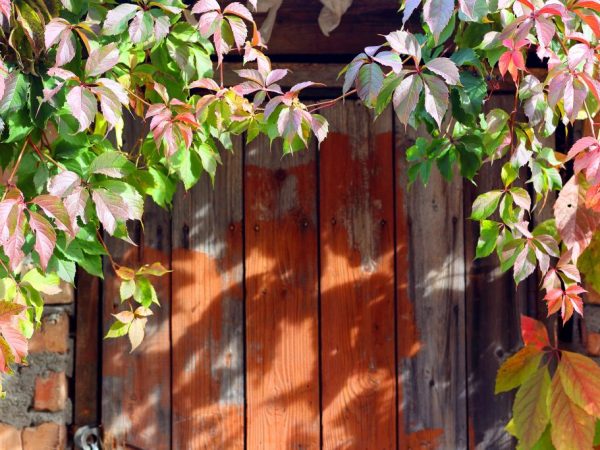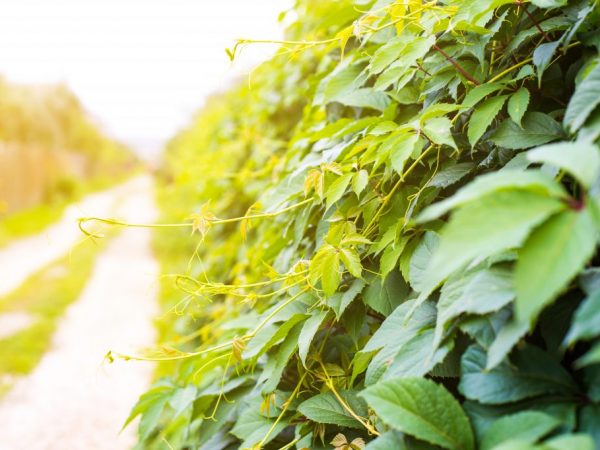Growing wild grapes on the fence
Among all ornamental plants, wild grapes are the most popular in horticulture. It is used in landscape design as shading balconies, terraces, gazebos of thickets. It is often planted along fences. As it grows, the decorative liana densely braids any building, creating a lush and dense decoration.

Growing wild grapes on the fence
Varietal characteristics
The liana-shaped perennial ornamental deciduous plant is characterized by rapid growth and development of shoots. The leaves are dark green in color, elongated, ovoid, with a pointed end. The edges of the plate are jagged.
The leaves are collected in five-leafed leaves. With the onset of autumn, almost all varieties of wild grapes change color to burgundy purple or purple. The berries ripen by autumn. The dark blue fruit is unsuitable for human consumption.
Wild grapes with bright rich foliage and beautiful berries are a real decoration not only on the fence, but also on any other outbuilding.
There are 10 varieties of this plant, but the most popular is the five-leaf wild grape. The second name is Virginian. In floristry it is called "parthenocissus".
With good care, wild grapes on the fence reach 20-25 m in height. This type is suitable for decorating buildings and structures of various sizes.
Application
Wild grapes adorn all the inconspicuous and unattractive places of the garden plot.
The loach plant creates unusually beautiful thickets along the fence, arbors. Terraces are decorated with wild plants. Beautiful hedges in the form of various shapes are created from it.
Liana is planted as a ground cover plant. The variety copes well with the function of a hedge. It is used for the preparation of medicinal products.
The shoots and leaves of the plant are given to rabbits. It is an excellent food for them, rich in vitamins and minerals.
Useful properties of fruits
In folk medicine, fruits are used to prepare remedies for many ailments:
- diseases of the gastrointestinal tract;
- diarrhea, diarrhea;
- increased acidity of the stomach;
- increased hemoglobin.
Also, medications from the fruits of wild grapes help improve blood and metabolism.
The berries of the plant should not be eaten, especially in large quantities: maiden grapes are poisonous, it can lead to severe intoxication of the body.
Dignity
Description of the characteristics of the variety:
- grows in any soil;
- easily tolerates drought, due to undemanding moisture;
- grows both in the sun and in partial shade;
- characterized by high frost resistance and intensive growth (one year after planting it reaches 3 m in height);
- grows without top dressing;
- rarely attacked by pests and diseases.
disadvantages

Grapes need to be trimmed regularly
Disadvantages of wild grapes:
- a massive and rapidly growing root system of a vine is capable of destroying a fence, especially if it is built of cement or corrugated board;
- if you plant grapes along the fence with other plants, the neighbors' chance for further growth and development is small (the root system of the maiden grapes will take away all moisture and nutrients);
- given that the plant has a late growing season, until the beginning of summer the fence will be bare, it will begin to be covered with emerald foliage only in July;
- in the process of growing, the decorative liana needs a regular haircut.
It is difficult to get rid of an intensively growing plant. To completely destroy and remove the wild liana, you will need to carry out a number of measures: completely remove the shoots, repeatedly water the roots and soil with herbicides.
Growing features
There are several ways to plant a plant, each of which has its own advantages and disadvantages.
Landing rules
The decorativeness of the plant depends on the planting site. In partial shade, the foliage will be dark green all year round. In a sunny place, the color of the leaves changes: at first it becomes dark green, with the onset of autumn it transforms into a purple hue.
To plant wild grapes in the country near a wall or fence should be at a distance of 1 m from each other. With such a distance, the cuttings will fully develop and braid all the voids.
To get a thicker hedge, you should plant the seedlings at a distance of 1 m from each other, and between them - cuttings or root suckers.
Site preparation and planting
A few days before planting the seedlings, deep digging of the soil and its leveling are performed.
A layer of drainage is laid in the dug holes about 50 cm deep on the bottom: broken bricks, shards, pebbles. A nutrient mixture of peat, leafy soil and sand is laid on top in a ratio of 2: 2: 1 immediately before planting. To improve the nutritional value of the soil, add 1 liter of wood ash. Such a composition will provide plants with nutrients for several years.
Liana is planted in the fall in order to observe its rapid growth and weaving in early spring. The cuttings are planted at a slope and to such a depth that the root collar remains level with the ground.
For convenience, it is permissible to dig a small hole for watering near each seedling. In order to successfully propagate a vine in this way, in the first few months the plants will have to be watered often and abundantly: 2-3 times a week, especially on hot days.
Planting care

Taking care of the plant is not difficult
Caring for wild grapes is simple and does not require any special knowledge:
Until the moment they take root (it will take about a month), the plants should be watered at least once a week, spending a bucket under each bush.
- Ordinary water from a well is suitable for irrigation; water at room temperature is required to irrigate the crown.
- After planting, the seedlings should not be mulched, otherwise their roots will suffocate and die due to lack of oxygen.
- The plant is planted not only on a fence, a wall, but also as a ground cover liana, which rapidly covers the ground with shoots and foliage. When planting seedlings along the fence, they try to immediately direct the shoots in the right direction.
- In the process of growing, the decorative liana needs shaping and sanitary pruning. The first procedure is carried out to give the shrub the desired shape and direction. Sanitary pruning of wild grapes involves the removal of wilted, broken off and shriveled shoots. It is also worthwhile to periodically thin out thickened areas in order to improve air circulation and avoid the appearance of pests and diseases. In case of severe frostbite, a cardinal pruning of the dead branches is carried out. This manipulation prevents them from rotting in the spring.
- Despite the fact that the decorative liana grows successfully without additional fertilizing, when nutrients are added, its growth is accelerated and decorative qualities are increased.
- In winter, this frost-resistant plant does not need shelter, which greatly facilitates its care.
Breeding features
The decorative loach reproduces in several ways: by layers, root suckers, cuttings and seeds.
Layers
Reproduction by layering is carried out during the spring-autumn period. Shoots are removed from the mother bush without mechanical separation. For the length of each shoot, the corresponding grooves are pulled out with a depth of about 5 cm. The same nutrient mixture is placed on the bottom as when planting seedlings or cuttings. Instead of this composition, it is permissible to use another substrate - compost (rotted manure) and peat.
Studs or staples are required to fix the shoots. They press the branches tightly to the ground. The foliage that is on the vine is left on top of the soil. Plantings are watered abundantly. After about a year, the cuttings release roots. Then they need to be separated from the mother bush. This procedure is usually carried out at the end of the summer.
Layers are divided into parts so that each delenka has roots, and are seated separately at a distance of 60-80 cm from each other. Such reproduction makes it possible to get full-fledged vines with a height of 2 m to 3 m the next year.
Cuttings
It is possible to grow girlish grapes with the help of cuttings. This is a laborious method. Harvesting of planting material is carried out in the spring, at the beginning of the growing season. For planting, use last year's branches and divide them into several segments so that on each segment there are at least 2 sleeping and 2 active buds.
Some gardeners cut cuttings in the fall to germinate young vines at home and then plant them in open ground in the spring. Planting cuttings at home is carried out according to the scheme of 20 x 25 cm in a well-moistened mixture. As they grow, they are seated in separate containers. It is better to plant each stalk separately in a pot.
After about a year, the cuttings will take root in the apartment, and in the spring, as soon as the heat stabilizes, they are planted in a permanent place in the garden near the fence, walls or other buildings.
If the cuttings are germinated in the spring, the site for planting them should be prepared in advance: dig up, level and water.
Seeds
Maiden grapes are bred by seeds. This is the most time consuming method. Before sowing, the seeds must be stratified. Its stages:
- seeds are soaked in cold water for 6 hours;
- sprinkle with a thick layer of wet sand, mix;
- placed in a plastic bag and kept in the refrigerator for a week.
After stratification in the refrigerator, the seeds are immersed in water at room temperature for a couple of hours. Swollen seeds are sown in open ground or seedling containers of 2 pcs.
If you sow seeds in the spring (in April), they will sprout in a month. When sowing seeds in the fall, the first shoots will not hatch soon; it will be possible to plant the plants along the fence only the next year in the middle of summer.
This method of reproduction is rarely used, since the seeds give 40-50% germination.
Root processes
You can also plant wild grapes with root suckers. These are ready-made young fathoms. They are carefully separated from the parent plant with roots and planted along the fence.
Planting is carried out according to the same principle as planting seedlings.
Conclusion
If you make a little effort and provide proper care for wild grapes, you will be able to grow a beautiful decorative element. Also, the plant is used for the preparation of folk remedies and the treatment of ailments.


